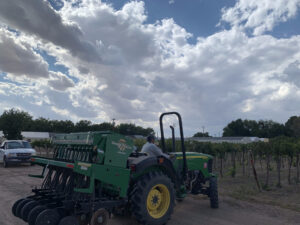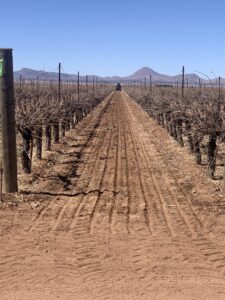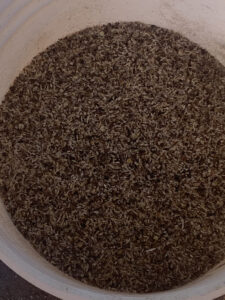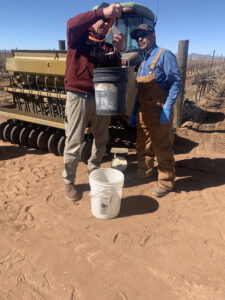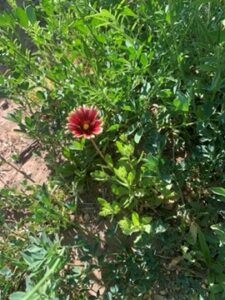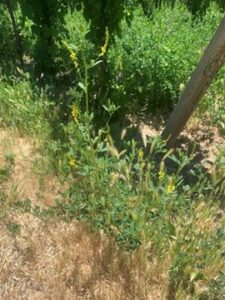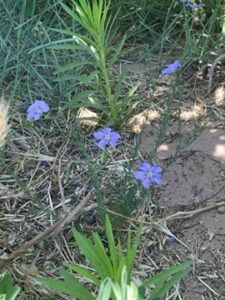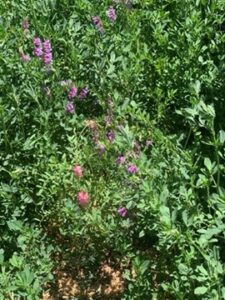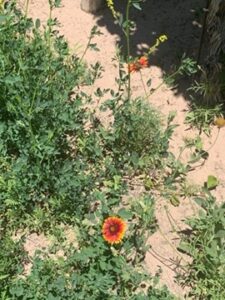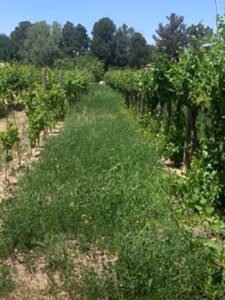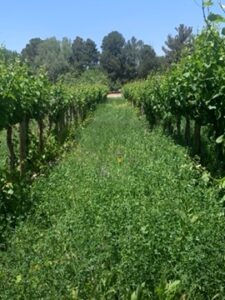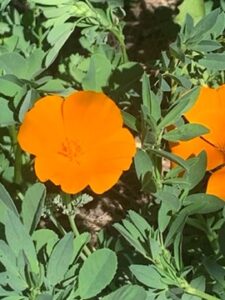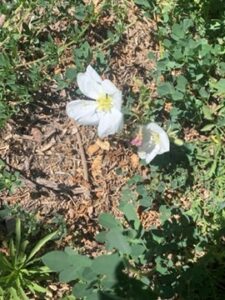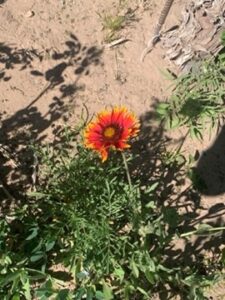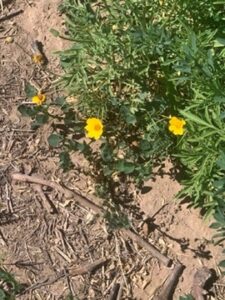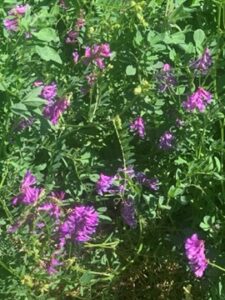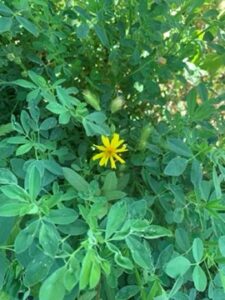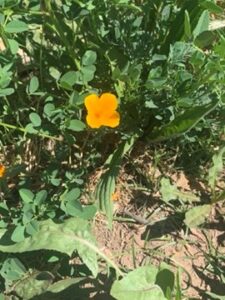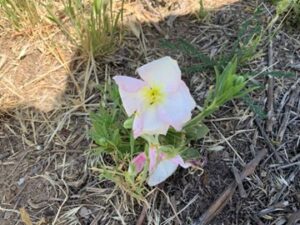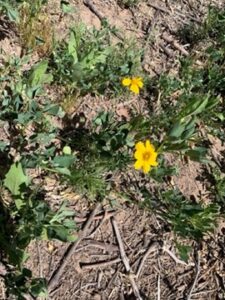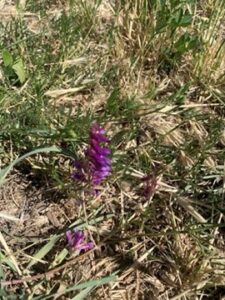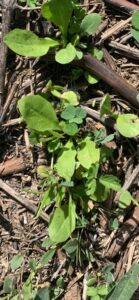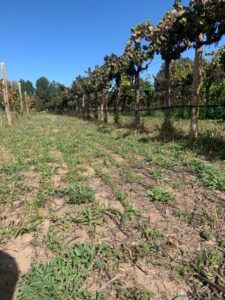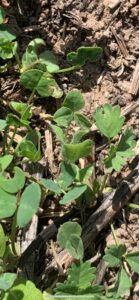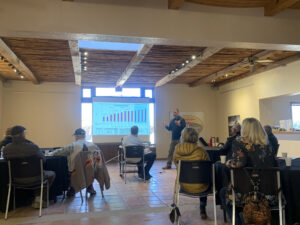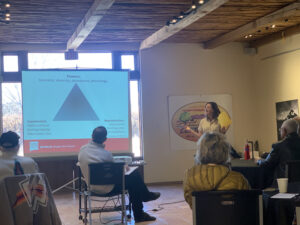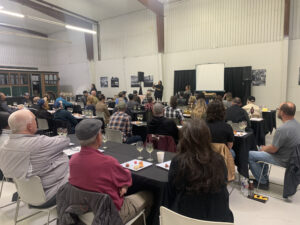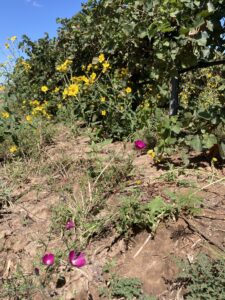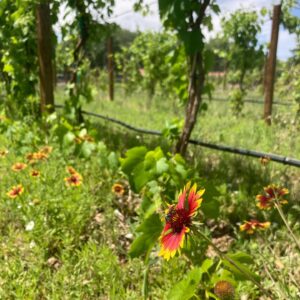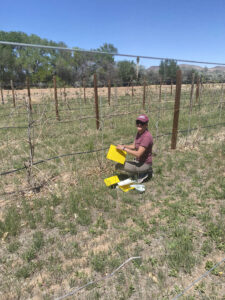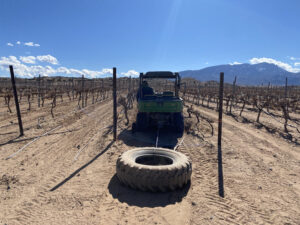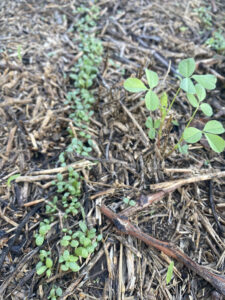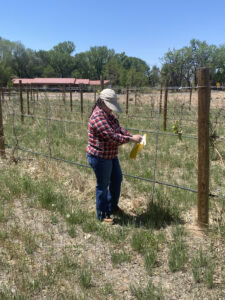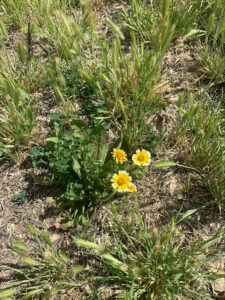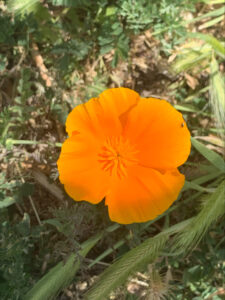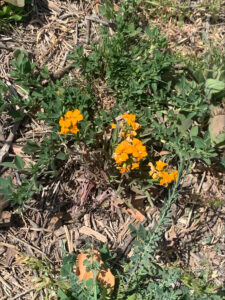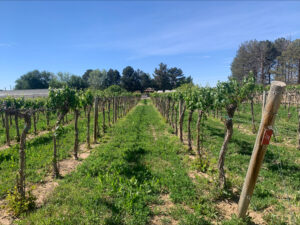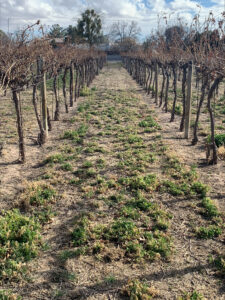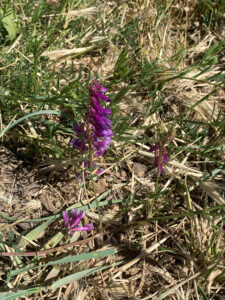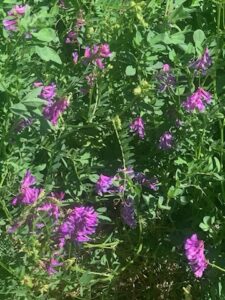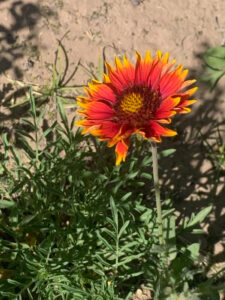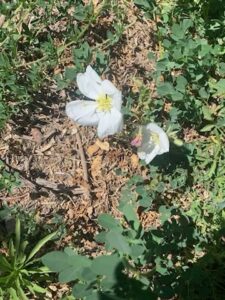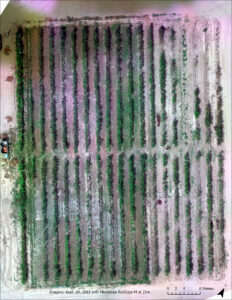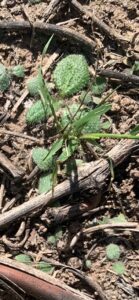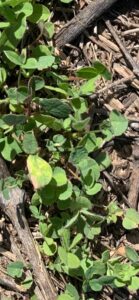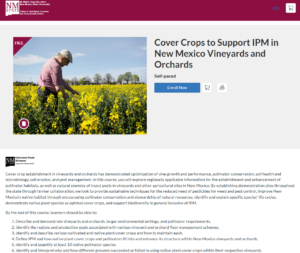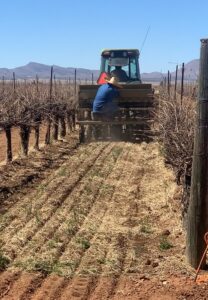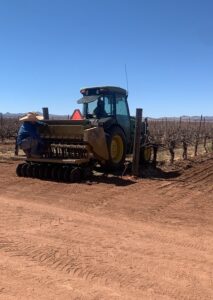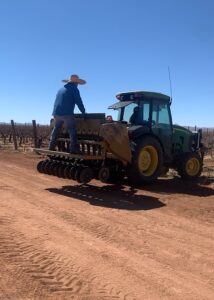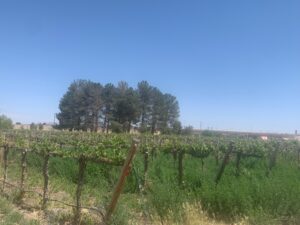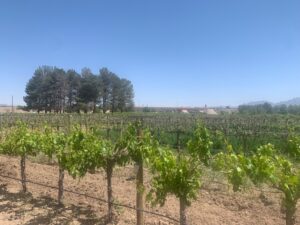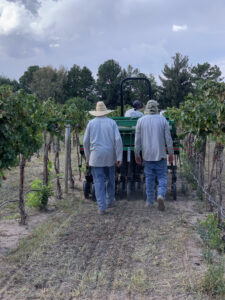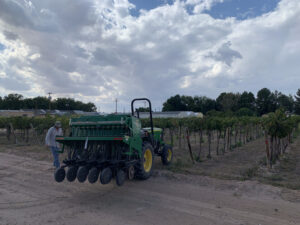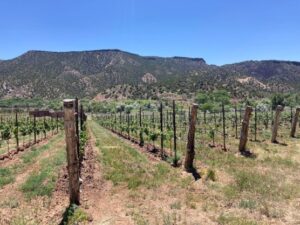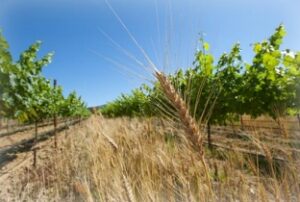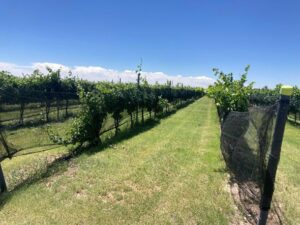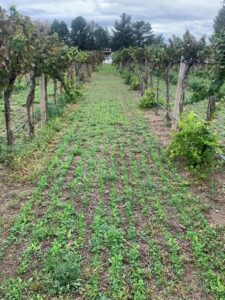Final report for WRGR21-005
Project Information
Several SARE projects have demonstrated the effectiveness of cover crops on different aspects of vineyard management including optimization of vine growth and performance, pest management, pollinator conservation, and soil health and microbiology, and reduction of soil erosion. The proposed project will build on SARE’s previous projects with the addition of regionally applicable information to establish and enhance habitat for pollinators and natural enemies of insect pests in vineyards and other agricultural sites. The work is located in the semi-arid southwest US, which has been underserved in this area of research despite the growth of the regions’ grape growing industry. Several native plant species that thrive in this region will be used as cover crops. This work accomplishes two of SARE’s program goals: 1) Increasing native habitat to encourage stewardship of natural resources and 2) provide sustainable methods to reduce the need for pesticides for weed and pest control. This project establishes demonstration sites throughout the state with farmer investment, supports workshops, and aids the creation of instructional/informational media and original videos of project impacts and progress.
Due to the ongoing pandemic, most work emphasis will be on creating and developing education materials, and conducting several limited attendance workshops. Planted cover crops will remain in place when we are beyond past this current health crisis and growers and researchers can meet in person again.
Objective 1: Establishment of six demonstration plots on 8 acres at experimental and commercial vineyards. Experimental vineyards at NMSU Agricultural Science Centers include Los Lunas Agriculture Science Center, Valencia County, NM (1 ac), and Fabian Garcia Agriculture Science Center, Doña Ana County, NM (3 ac). Commercial vineyards include Pueblo of Santa Ana vineyard, Sandoval County, NM (30 ac, 2 acre dedicated), Lescombes vineyard, Grants County, NM (240 ac, 2 acre dedicated), and Amaro winery vineyards, Doña Ana County, NM (30 ac, 10 acre dedicated).
Objective 2: To increase knowledge and awareness of benefits of cover crops in vineyards in the Southwest
- Presentations on creating habitat, its benefits, and identification of pollinators and natural enemies of pests
- Webinar-based training course on “Cover Crops to Enhance Native Pollinators and Manage Insect Pests of Vineyards and Orchards”. The course will be incorporated into existing Pesticide Applicator Training for CEUs.
- Due to ongoing and evolving COVID-19 pandemic regulations and restrictions that impact the ability of face to face group gatherings for the foreseeable future, we will create online resources and conduct a workshop webinar series on cover crop role in vineyard management, pollinator conservation and integrated pest management in vineyards, as well as soil health conservation, and other related topics.
Several SARE projects have demonstrated the effectiveness of cover crops on different aspects of vineyard management including pest management, pollinator conservation, and soil microbiology (8-10). These projects were successful in California and Washington, but were not tested in an arid, desert climate. Similar work has proven the concept in European vineyards (3). We will introduce these cover crop management techniques to grape growers in New Mexico and assess their viability in the southwest. Vineyards produce a high-value specialty crop (wine and/or table grapes), and therefore, are often intensely managed. The agricultural component of the state’s winegrowing industry is modest with approximately 52 commercial producers and 1,100 acres planted. However, the entire New Mexico wine industry, that includes retail and hospitality, generates approximately $4.4 million in federal consumption taxes and $22.2 million in state consumption taxes which include excise and sales taxes (11). Current vineyard practice includes large areas of cultivated soil in the row-middles that is practically bare for most of the year. These exposed areas are subject to wind and water erosion, and the exposed condition is detrimental to much of any native soil microbiome. Our goal is to enhance the sustainability of these vineyard production systems in a resource limited climate that needs careful locally adapted consideration for management techniques.
New Mexico’s pollinator population is one of the most diverse in the United States with over 1,000 species of native bees and over 350 species of butterflies. However, pollinator populations are in decline, threatened by habitat loss, chemical use, and pressure from pests and diseases (12). Cover crops can provide a way to increase the habitat resources (food resources and nesting sites) needed for the conservation of these species (13). Although grapes do not require pollination to thrive, creating a system that supports cover crops and provides diverse agro-ecosystems is important for increasing sustainability. Cover crops provide a stable working “floor” to support human and mechanized vineyard operations, as well as build soil organic matter and reduce soil erosion (5). The same cover crops that support native pollinators and beneficial insects lead to increased ecosystem services and conservation of these species. Cover crops that support beneficial insects may increase biological control of nematode and insect pests in vineyards (14). Flowering cover crops can result in a greater diversity and abundance of bees than weedy vegetation 15). However, native species may be preferable as cover crops in this region, because irrigated non-native cover crops, such as buckwheat, can increase pest populations (16). Furthermore, native plant species often support more native pollinators than non-native plant species, and once established may require less maintenance and resources, especially irrigation water.
Current recommendations often focus on planting a multi-species cover crop mix to best benefit multiple pollinator species (17). Recent research at New Mexico State University has evaluated and ranked several native plants for their attractiveness to beneficial insects. This list of regionally adapted species (18) has not yet been thoroughly demonstrated as to how they can best be incorporated into agricultural settings.
Cooperators
- - Producer (Educator and Researcher)
- - Producer
- (Researcher)
- - Producer (Researcher)
- (Researcher)
Education & Outreach Initiatives
Demonstrate seeding of native species as vineyard cover crops
Explain/describe selected native species cover crops
Demonstrate no-till seeder in vineyard setting
Experienced growers/collaborators at NMSU Fabian Garcia Research Farm, Lescombes and Santa Ana Pueblo vineyards will demonstrate seeding process of the selected seed mix of ~26 native, perennial and annual species in the vineyard row middles. Explain the equipment and the sub-surface drip irrigation to deliver water to facilitate germination and maintenance of the cover crop.
Learning: native species selection, seeding rate and depth, use of the no-till seeder in vineyard setting,
Outcomes: grower exposure to native species most likely to succeed, equipment selection and use, soil preparation/disturbance (minimal) required
Demonstrate the growth of native species as vineyard cover crops
Identify the growth of certain native species seeded in the seeding locations of each cover crop
Learning: Native species identification, native species growth, native species educated-selection
Outcomes: grower exposure to accurate native species identification practices, growth habits of native species, and native species suitability for New Mexican vineyards.
Educational & Outreach Activities
Participation summary:
Four (4) Field day tours at NMSU Agricultural Science Centers, Alcalde, Farmington, Las Cruces and Los Lunas (summer 2021)
Three (3) Field day tours at NMSU Agricultural Science Centers, Farmington, Las Cruces and Los Lunas (summer 2022)
Two (2) Field day tours at NMSU Agricultural Science Center, Las Cruces and Los Lunas (summer 2023)
Two (2) Field day tours at NMSU Agricultural Science Center, Las Cruces and Los Lunas (summer 2024)
Seventeen (17) presentations
- @2021 New Mexico Sustainable Agriculture Online Conference - Promoting Beneficial Insects (Dec. 9, 2021)
- Webinar, with Encanto Garden Group Albuquerque (January 2022)
- Workshop, Fabian Garcia Science Center, Las Cruces (February 26, 2022)
- @ Northern New Mexico Fruit Growers - , Abiquiu, NM (March 2, 2022)
- Two (2) presentations @New Mexico Winegrowers Association Educational Conference, March 15-16, 2022, Los Ranchos Agri-Nature Center, Albuquerque, NM
- Gill Giese and Miranda Kersten – Cover Crops in Vineyards
- Guest speaker, Dr. David James, Washington State University, “ Beauty with Benefits: Naturescaping Washington Vineyards for Biological Control and Biodiversity“
- @2022 NM Agriculture Sustainability Workshop, June 27-29, 2022, Las Cruces, NM – Beneficial Insects
- @ 46th Annual Conference of the American Society for Enology and Viticulture-Eastern Section, July 13-15, 2022, Bloomington, MN – Climate, Soil and Phenology of New Mexico Vineyards
- Two (2) presentations @ NM Winegrowers ‘Grape Day’ technical session - Central New Mexico Community College, Albuquerque, NM. July 20, 2022
- Guest speaker - Dr. John Clark – Variety Development and Matching Cultivar to Site
- Gill Giese – Climate Change vs. Vineyards in New Mexico
- Two (2) presentations @New Mexico Winegrowers Association Educational Conference, February 26-28, 2023, Santa Fe, NM
- Miranda Kersten and Maryel Lopez – Cover Crops in Vineyards
- @National Native Seed Conference, March 27-30, 2023, Washington, D.C.
- Miranda Kersten - Native Habitat Enhancement for Pollinators in New Mexico vineyards
- Three (3) presentations @47th Annual American Society for Enology and Viticulture Eastern Section Conference, Jun 7-9, 2023, Austin, TX
- Gill Giese - Climate Change vs. Vineyards in New Mexico
- Miranda Kersten - Native Habitat Enhancement for Pollinators in New Mexico Vineyards
- Maryel Lopez - Influence of Cover Crop Planting on Vine Nutrients and Berry Chemistry in a Southern New Mexico Malbec Vineyard
- @conference of northern New Mexico Fruit Growers, Santa Fe, NM (February 2024)
One (1) ACES Magazine article, Agricultural, Consumer and Environmental Sciences NMSU (February 2022), https://aces-about.nmsu.edu/documents/ACESMagazine_SP22_ADA.pdf
One (1) NMSU Newsroom article (August 2022), https://newsroom.nmsu.edu/news/grape-expectations--aes-project-examines-how-cover-crops-can-improve-vineyards-and-pollinator-habita/s/66964fe4-8794-41f9-a95b-1d1c814ede56
One (1) Extension publication, Circular 705: Grape Integrated Pest Management (IPM) in New Mexico, Miranda Kersten and Gill Giese, https://pubs.nmsu.edu/_circulars/CR705/index.html
One (1) Article by Steve Elliott, Western IPM Center (October 2022): http://westernipm.org/index.cfm/ipm-in-the-west/agriculture/planting-cover-crops-in-vineyards-for-ipm-and-soil-health-benefits/
One (1) Video by Steve Elliott, Western IPM Center (October 2022): https://youtu.be/7n4OUsv7Ga4
Five (5) on-farm demonstrations: Lescombes Vineyard, Lordsburg, NM , Santa Ana Pueblo Vineyard, Bernalillo, NM; Noisy Water Vineyard, Rincon, NM; Los Lunas Agricultural Science Center, Los Lunas, NM; Fabian Garcia Agricultural Science Center, Las Cruces, NM (planted spring/summer 2022 with insect collections in summer 2022)
Three (3) on-farm demonstrations: Lescombes Vineyard, Lordsburg, NM , Los Lunas Agricultural Science Center, Los Lunas, NM; Fabian Garcia Agricultural Science Center, Las Cruces, NM (cover crop assessment and insect collection, spring-summer 2023)
Two (2) on-farm demonstrations: Los Lunas Agricultural Science Center, Los Lunas and Fabian Garcia Agricultural Science Center, Las Cruces, NM (cover crop assessment and insect collection, spring-summer 2024)
One (1) free online training course: Cover Crops to Support IPM in New Mexico Vineyards and Orchards, available through Microlearning by NMSU Global Campus and launched on November 2024.
Learning Outcomes
Project Outcomes
Several farmers have been made aware of methods to achieve possible and potential benefits of cover cropping vineyard row middles in the harsh and arid environment of New Mexico. This educational initiative introduced farmers to the advantages of establishing native cover crops for their vineyard ecosystem and health. They engaged on cover crop seeding strategies, encompassing the proper timing and methods for successful establishments. Some farmers with extensive previous experience and practice furthered their knowledge about native seed selection, suitability, and identification. By the incorporation of native plant species in their vineyards, farmers learned about qualitative benefits such as soil erosion control, weed suppression, and soil structure improvement. In fact, vineyards with seeded cover crops were seen to require less rootstock covering-related labor during the winter months than areas where wind and water run-off were not reduced. Furthermore, abundance of native species in the soil coverage, outcompeted visible presence of weeds.
The program also instructed farmers on how to select native plant species that would best suit their vineyards and targeted goals. Once seeded, farmers learned about identification methods, cover crop management strategies, and best practices. Farmers and ag professionals had the opportunity to address their highest-priority concern: cover crop maintenance and irrigation. Through educational sessions and the developed online educational course, practical guidance on irrigation for cover crops in New Mexico vineyards was provided. Due to the known water scarcity issues and limitations of the region, discussions on techniques such as drip irrigation and strategies such as irrigation timing and frequency were also included during presentations. Native pollinator presence in New Mexican vineyards was one of the main program’s focuses. To align to this goal, farmers were introduced to pollinator sampling methods, general native pollinator identification, and methods to foster their environments like cover crop seeding.
- Vivac Winery has found several benefits of having ground cover vegetation in their vineyard, particularly as an alternative to pesticide use and for the aesthetic value. They find cover crops visually appealing and consider them essential to prevent the land from appearing barren. Initially, they planted a specific mix of cover crops, including sorghums, peas, clovers, and grasses. These cover crops were intended to provide natural sources of nitrogen, reducing the need for external inputs like mulch and manure. Unfortunately, challenges arose in maintaining the cover crops due to issues with irrigation and moisture retention. In some parts of the vineyard, they have installed overhead sprinklers for the ground cover, but in newer sections, the inter-rows do not receive any supplemental irrigation. Despite some drawbacks to the cover crops, such as the need for occasional mowing, they value the cover crops for their potential to fix nitrogen, prevent erosion caused by wind and rain, and maintain soil stability. They tolerate the presence of weeds in the inter-rows if it means the soil remains anchored. They find cover crops beneficial for promoting sustainability, reducing erosion, improving soil structure, and fostering a healthier ecosystem. While challenges exist in maintaining cover crops effectively, their commitment to being part of nature's balance underscores the importance of these practices in vineyard management.
- In the Amaro Winery Vineyards, planting cover crops has not been a common practice. Due to the vineyard’s location on a hilly slope, flooding is not a possible irrigation method and getting water in the inter row areas is difficult. This complicates the process of seeding, irrigating, and
maintaining cover crops. It was mentioned that instead, they work on promoting the growth of native vegetation such as dessert grasses which have been observed to decrease erosion, improve soil moisture retention, and improve soil structure helpful for labor. A triticale and annual ryegrass mix was planted in Fall 2023. Both triticale and ryegrass were successfully established in the vineyard. The cover crop did not require any additional water or irrigation than the monsoon rains received around the seeding time. According to the owner at Amaro Winery Vineyards and management team, the major benefits of seeding this mix involved qualitative observations of erosion mitigation, soil moisture retention, and weed control.
- Enchantment Vineyards has seen many benefits of using Curtis and Curtis’s "Native Wonder" grass mix ground cover in their vineyards. This grass mix is comprised of blue grama and buffalo grass. The selection of this grass mix is significant because it requires minimal moisture, which is favorable for the vineyard's needs. Prior to being a vineyard, this area was a fallow field, which had a mixture of weeds, including bindweed. Instead of tilling the land, they opted to seed it over, which involved spraying the area to control the weed population and then hired Curtis and Curtis to use an actual grass seed drill for planting. Proper establishment techniques are critical for a successful cover crop. In summary, the use of the "Native Wonder" grass mix as a cover crop in the vineyard offers benefits such as low water requirements and compatibility with existing vegetation. The choice to seed over fallow field instead of tilling, along with professional assistance for proper seeding, underscores the practical advantages of using cover crops in vineyard management. They have seen many benefits in terms of weed control and soil erosion, especially during high wind events.
- In the educational vineyard at Fabian Garcia ASC, 60 lbs. of a custom wildflower and perennial pollinator mix were seeded in Fall 2022. The cover crop benefited the workers during maintenance practices and students during harvest by providing a stable soil platform. Weed management labor, leafhopper incidence, and decreased in the areas where the cover crop was installed. Additionally, soil moisture was preserved, and lower soil temperatures were detected around the cover crop. Flowering plants attracted native pollinators and leafhopper populations were less observed in the canopy than in the cover crop. These flowers also added an aesthetic aspect to the inter rows of the vineyard. Mowing was required every 15 days (about 2 weeks) due to the rapidly growing alfalfa included in the mix. The cover crop provided natural sources of nitrogen, and no external inputs needed to be added. In overall, it was observed that the cover crop benefited the vineyard ecosystem, vine, and soil health.
The prevailing concern amid the arid conditions and water scarcity in vineyards across the Southwest remains a high priority for New Mexican farmers. During this project, it was observed that although all seed mixes contained native species known to thrive in the region and be drought resistant, several species failed to germinate or grow successfully. A very experienced farmer in La Mesa, NM seeded his cover crop during the monsoon season, specifically on the day the region received the most intense rainfall of the year. In this instance, the cover crop thrived, and after some initial failures in different locations, it was understood that abundance of water is required during and after the seeding process to achieve successful establishment, although this is not true for all native species. This presents a valuable opportunity for future studies addressing regional variability in native plant success, optimal seeding timing, irrigation requirements, and water efficiency in native cover crops.
Additionally, the green leafhopper is a prevalent pest in New Mexican vineyards. Large populations of these insects were observed over the years in vineyards with and without established cover crops. While no quantitative evaluation was conducted in this study, this presents another opportunity to further investigate its prevalence in vineyards and its correlation with native plant species.
Lastly, another area worth exploring in future studies is the soil microbiome and native plant interactions in vineyards, along with long-term impact of native cover crops on the physical and chemical performance of New Mexican vineyards.
